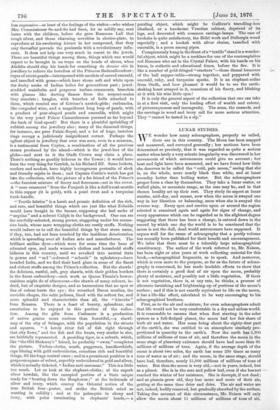LUNAR STUDIES.
WE wonder how many selenographers, properly so -called, there are in this country. The Moon has been mapped and measured, and surveyed generally ; her motions have been determined so precisely, that it was regarded as quite a serious matter when lately a very minute irregularity was discovered in her movements of which astronomers could give no account ; her heat and light have been measured, and we have found how little she deserves to be called the " cold, pale moon," seeing that she is, on the whole, more nearly black than white, and at lunar noonday hotter than boiling water. But the selenographers proper form a class by themselves. They take a lunar crater, or walled plain, or mountain range, as the case may be, and in that chosen locality set up their rest. They study its aspect at lunar sunrise, mid-day, and sunset, now when the moon is swayed one way in her libration or balancing, anon when she is swayed the reverse way. Every spot and crevice upon or around the region selected is examined again and again for signs of change, and every appearance which can be regarded as in the slightest degree suggesting that there has been a change, is entered down in the record by which one day the world is to be convinced that the moon is not the dull, dead world astronomers have supposed. It argues well for the cause of selenography that a portly volume has recently been published for their benefit and encouragement. We infer that there must be a tolerably large selenographical constituency. The author of the work referred to, Mr. Neison, has been eight or nine years at work collecting material for this book,—selenographical fragments, so to speak. And moreover, which-is even more to the purpose, so far as the future of seleno- graphy is concerned, he has made laudable efforts to show that there is certainly a good deal of air upon the moon, probably plenty of moisture, and possibly not a little vegetation. If there is not vegetation, there is, at any rate, he thinks, a process of alternate tarnishing and brightening-up of portions of the moon's surface ; and if this is not exactly equivalent to life on the moon, it has a life-like effect, calculated to be very encouraging to his selenomphical brethren.
First, as to the air and moisture, for even selenographers admit that life would not be very comfortable in a dry and airless world. It is reasonable to assume that when first starting in the solar system as a full-fledged planet, the moon had her fair share of both air and water. Her mass being about the eighty-first part of the earth's, she was entitled to an atmosphere similarly pro- portioned in quantity to the earth's. Now the earth has 5,300 millions of millions of tons of air, and therefore the moon in the same stage of planetary existence should have had more than 65 millions of millions of tons. Again, if the average depth of the ocean is about two miles, the earth has some 230 times as many tons of water as of air ; and the moon, in the same stage, should have had, therefore, nearly 15,000 millions of millions of tons of water. But then the moon is very old,—not in years, indeed, but as a planet. She is in the sere and yellow leaf, even if she has not -.- reached the winter of her existence. She is decrepit, if not dead ; and as planets grow old, they lose more and more of their air, getting at the same time drier and drier. The air and water are not, indeed, bodily removed, but gradually absorbed by the surface. Taking due account of this circumstance, Mr. Neison will only allow the moon about 11 millions of millions of tone of air, and no surface -water at all, only a moist crust. But as he truly remarks, that is a great deal of air, after all, and a great deal might happen with a moist crust which would not happen with a dry one. Eleven millions of millions of tons of air should count for something in the economy of our satellite, and the warm rays of the sun poured during the long lunar day (a fortnight of our time) without intermission upon the moon's moist surface ought to effect changes of some sort. If selenographers have not yet noted important changes thus occasioned, then all the better reason is there why they should examine the lunar features more and more searchingly, till they find the evidence they require.
There are two lunar spots which the selenographer regards with special favour, because of the evidence they seem to give of change. One is a crater lying on the so-called Sea of Serenity, which some popular lunar observers regard as the left eye of the Man in the Moon. Here there was once a deep crater, nearly seven miles across, a very distinct and obvious feature even with the small telescope (less than four inches in aperture) used by Beer and Midler in forming their celebrated chart. But, ten years ago, the skilful astronomer Schmidt, a selenographer of seleno- graphers—who has, in fact, given the best energies of his life to moon-gazing—found this crater missing. When he announced the fact to the scientific world, other astronomers, armed with very powerful instruments, looked for the crater which had been so clearly seen with Madler's small telescope ; but though they found a crater, it was nothing like the crater described by Midler. The present crater is scarcely two miles in diameter, and only just visible with powerful telescopes ; all around it there is a shallow depression, occupying a region about as large as the whole crater had been before. It seems impossible to doubt that a great change has taken place here, and the question arises whether the change has been produced by volcanic activity or otherwise. Sir John Herschel pronounced somewhat confidently in favour of the former hypothesis. "The most plausible conjecture," said he, "as to the cause of this disappearance seems to be the filling- up of the crater from beneath by an effusion of viscous lava, which, overflowing the rim on all sides, may have so flowed down the outer slope as to efface its ruggedness, and convert it into a gradual declivity, casting no stray shadows." But how tremendous the volcanic energy required to fill with lava a crater nearly seven miles in diameter, and more than half a mile deep ! The volcanic hypothesis seems on this account utterly incredible, for if such energy resided in the moon's interior, we should find her whole surface continually changing. Far more probable seems the idea that the wall of this crater has simply fallen in, scattering its fragments over what bad been the floor of the crater. The forces at work on the moon are quite competent to throw down steep crater-walls like those which seem formerly to have girt about this deep cavity. Under the tremendous and long-lasting heat of the lunar mid-day sun, the rock substance of the moon's surface must expand, while during the intense cold of the lunar night a corresponding contraction must take place. Under the influence of this alternate expansion and contraction, the strongest of the lunar crater-walls must be tending to their downfall. Their substance must be gradually crumbling away. From time to time, large masses must topple over, and occasion- ally long ranges of crater-wall must be brought to the ground. it seems conceivable enough, certainly far more probable than any other interpretation which has been offered, that the crater- wall first missed by Schmidt was destroyed in this way.
The other favourite region of selenographers is a much larger ene,—the great walled plain called Plato, and by the older astro- nomers the Greater Black Lake, sixty miles in diameter, and sur- rounded- by mountains, some of which rise nearly 2,500 yards above the level of the floor. According to the selenographers, the whole of this floor changes in aspect regularly during each lunar day,—the lunar day, be it remembered, being equal in length to what we terrestrials term a lunar month. In the lunar morning-hours the floor is light, during lunar mid-day it is dark, and in the evening it grows light again. The idea of seleno- graphers as to the cause of this change is that some pro- cess of vegetation takes place over this depressed floor (it lies more than half a mile below the mean lunar level) ; or else that vapours ascend when the sun's heat is poured on the floor and tarnish it in some way, while after mid-day heat has passed the vapours are reabsorbed, and the surface resumes its former lustre. The profane, however, urge that the -whole matter is a mere effect of contrast : in the morning and evening the black shadows of the surrounding mountains are thrown on part of the floor, and the rest by contrast
looks light, whereas at mid-day the same mountains (which are white and bright) form a ring of light all round the floor, which, therefore, looks dark by contrast. The selenogra- phers maintain, on the contrary, that they have not been de- ceived by contrast, and adhuc sub judice lis est.
One can understand that to those who have leisure to pore, after the selenographic fashion, into the details of our satellite's surface, the work must possess a certain charm. Though the nearest of all the heavenly bodies, the Moon still lies so far away that very minute apparent signs of change imply really important disturbances ; and though astronomers have given up the idea that there can be life of any sort on the surface of our satellite, yet she still has interest for many, as a world which was probably at one time the abode of many orders of living creatures.

































 Previous page
Previous page